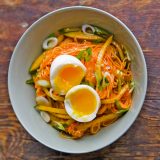American-style pasta salads usually call for curvy Italian noodles, such as fusilli or rotini, the ridges and grooves of which readily catch slick vinaigrettes and creamy dressings. It sounds like an asset but actually is the ruin of many recipes.
That’s because cooked Italian pasta rarely improves with time and moisture. It typically turns mushy as it absorbs dressing—and things only get worse when chilling comes into play. Because cold dulls flavor, the impact of the mildly seasoned dressings called for by most recipes is further diluted.
Our search for a solution brought us to bibim guksu, a cold Korean noodle salad that solves both problems thanks to a different style of noodle and a bevy of crisp, boldly flavored ingredients, including kimchi and spicy gochujang.
Whether ramen, lo mein, dang myun or udon, Asian noodles maintain their textural integrity even when dressed and served cold. This is because the variety of wheat flour found in Asian noodles contains less protein and starch than durum wheat, the latter being more prone to gelatinization that leads to gumminess.
The classic choice for bibim guksu is somyeon—called somen in Japan—a slender, cream-colored wheat noodle with a pleasantly toothsome chew. After a brief boil, the noodles are drained and covered with ice to halt cooking. Once cooled, they are rinsed under cold water, removing lingering starch that could otherwise leave the salad gummy or cause the noodles to clump.
The dish also gets texture from crisp vegetables, namely cucumber and scallions, which keep the salad refreshing, too. Thinly sliced cabbage kimchi plays a dual role, the fermented slaw-like side providing crunch as well as pops of funky-savory flavor.
Then there is the dressing—an assertive mix of acidity, sweetness and spice that readily resists the flavor-dulling chill factor. “Those three tastes create a craving and guarantee you finish your whole bowl,” says Hooni Kim, the chef behind the world’s first Michelin-starred Korean restaurant and author of the much-lauded cookbook “My Korea.”
Spicy-sweet gochujang, an umami-packed fermented chili paste, provides both heat and body. Tangy rice vinegar adds lightly sweet acidic notes. And toasted sesame oil binds everything together with deep richness. “The nuttiness and fat balance the sharpness of the dish,” says Kim. “Like everything with Korean food, it’s the balance.”
And though bibim guksu traditionally calls for the vegetables to be julienned into skinny strips, we prefer slightly thicker cuts, which provide a nice contrast to the chewy wheat noodles.
Light yet filling and packed with lively flavor and texture, this summery dish showcases the true potential of a chilled noodle salad.
For a Better Pasta Salad, Lose the Pasta!
Big flavors and chewy noodles are the secret to better chilled pasta salads.
Photo: Connie Miller of CB Creatives; Styling: Catherine Smart







